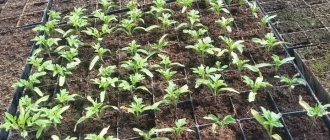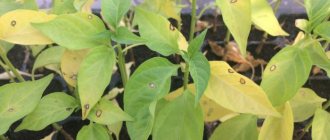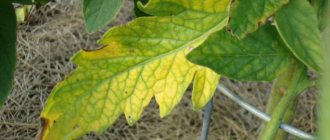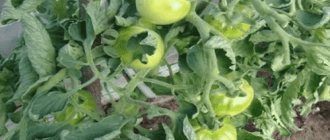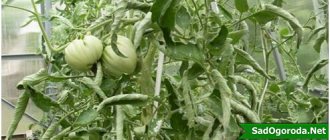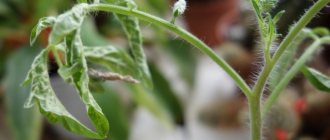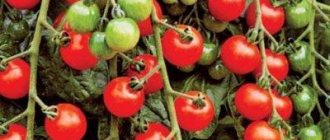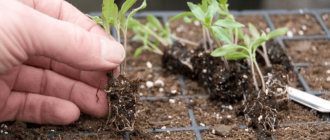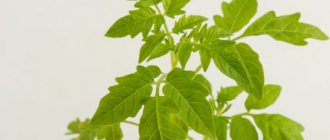Vegetable growing » Tomatoes
0
2242
Article rating
Kira Stoletova
Tomatoes are a plant that can cause a number of problems when cultivated. One of them is the weak condition of the leaves. Let's look at the reasons why the leaves of tomato seedlings fall.
Causes of leaves falling off in tomato seedlings
Yellowing and falling of the lower leaves is the first signal of improper care or violation of agricultural practices. If the cause is immediately detected and eliminated, the plant can be saved.
Improper watering
Tomatoes need regular moderate watering. Lack of moisture, as well as its excess, leads to tomato leaves falling off.
It is enough to water a young plant once every 4-5 days. If the room is dry and the soil dries out quickly, you can water it once every 2-3 days. The water should be settled and at room temperature. Cold water has a detrimental effect on the delicate roots, microflora and immunity of tomatoes.
If the room has high humidity, is cold or the seedlings are in the shade, then watering can be reduced. Excess moisture leads to rotting of the root system, the appearance of fungus in the soil and disease of all seedlings.
Signs of excess moisture
If tomatoes turn yellow and drop their leaves due to overwatering, then the first thing you need to do is inspect the soil. Clean soil does not require replacement. You just need to reduce the amount of watering. The presence of plaque, whitish spots or fluff, or a sour smell indicates that the seedlings need to be immediately transplanted into a clean, dry container and into a new soil mixture.
When replanting, carefully examine the roots of each bush. Healthy roots are white. If they are brown, then it is difficult to save the seedling - this indicates the beginning of decay.
Sudden changes in watering have a detrimental effect on seedlings. Periodic underwatering and overwatering become stressful for young bushes and growth slows down.
Diseases
The most common disease of tomatoes is late blight. This disease is provoked by a fungus that can initially infect one bush, and subsequently spread to all nearby crops of the nightshade family.
Late blight can affect not only adult plants growing in open ground and greenhouses, but also tomato seedlings. Infection can occur due to the reuse of untreated containers, as well as garden soil without proper preparation. In addition, late blight fungus can be found directly on tomato seeds.
Tomato disease appears 10-15 days after infection. At this time, dark, sometimes gray-brown spots form on the leaves and stems of tomatoes. If there is high humidity in the room, late blight is also indicated by a “fluffy” white coating on the back of the leaf. The initial stage of late blight may not be noticeable to the farmer at all, while spreading to nearby tomato seedlings. However, over time, the tomato leaves begin to become completely covered with dark spots and fall off.
Important! Phytophthora spores actively develop in a moist, cool environment. Their reproduction is also facilitated by sudden changes in temperature.
For the prevention and treatment of tomato seedlings, you can use special chemicals. However, their use should be limited to living rooms. For preventive purposes, you can use spraying with whey, the acids of which suppress the development of fungus.
You can knowingly protect plants from late blight by treating all the elements involved in the process of growing seedlings:
- Tomato seeds must be treated with a solution of potassium permanganate or wood ash before sowing.
- The soil from the garden must be subjected to heat treatment. To do this, place the container with soil in an oven at a temperature of 170-2000C for 1.5-2 hours. This will kill all pathogenic bacteria, fungi and parasite larvae.
- Plastic containers in which seedlings were previously cultivated should be disinfected. For these purposes, you can prepare a solution of bleach, which must be mixed with water in a ratio of 1:10.
Thus, it is easier to prevent the development of late blight than to later save tomato seedlings affected by the fungus in every possible way. Additional information about ways to prevent and treat this disease can be found in the video:
Lack of lighting
Tomato is a light-loving crop. Cultivation begins in February - March, when daylight hours are still short. With a lack of lighting, plants stretch, leaves develop poorly, and may begin to turn yellow and fall off. There are two ways to solve the problem:
- Add artificial lighting.
- Grow seedlings in the brightest window.
Regular incandescent lamps are of no use. It is better to use LED lamps. Their light is optimal for seedlings.
Tatyana Orlova (candidate of agricultural sciences):
Even on a south-facing window, the sun is no more than 3-4 hours a day. In this case, the plants are illuminated only on one side, the other remains in the shadow. To eliminate the deficiency of light, fluorescent fluorescent lamps are used. They are placed on top of the seedlings at a distance of no more than 1 meter.
Presence of diseases and pests
Quite often, the green crown begins to wither, turn yellow and fall off during illness or when attacked by pests.
Tomato seedlings usually have strong immunity, but in the presence of accompanying unfavorable conditions (dense plantings, too much watering), fungal infections such as black leg, fusarium, and various rots can develop on them. To avoid the risk of their spread, seed material must be treated before planting, and planting containers must be thoroughly disinfected.
Blackleg causes thinning of the stems with the formation of constrictions at the base of the stem. For protection, you can treat the soil with a solution of potassium permanganate. If the infection spreads massively, the affected seedlings will have to be destroyed.
The initial symptom of fusarium is yellowed lower leaves that begin to fall off. As the disease progresses, it completely covers the bush.
The stem cut turns brown. The main therapeutic methods are as follows: reducing the amount of watering, using fungicides (Fitosporin solution is effective).
Pests such as spider mites, aphids, and greenhouse whiteflies are dangerous for tomato seedlings. The main symptoms of infection are leaf curling. Then it begins to turn yellow and fall off.
Insects are gotten rid of by treating the plantings with tobacco or garlic infusion, Actellik or Fitoverm insecticides.
Lack of nutrients in the soil
Lack of nitrogen negatively affects plants
Young bushes grow quickly and require regular feeding. Before flowering begins, plants actively increase their green mass. The main building element is nitrogen. It is its deficiency that leads to yellowing and death of the lower leaves.
Nitrogen deficiency can be remedied by applying organic fertilizers. It must be remembered that excess nitrogen can have a detrimental effect on future harvests. Active growth of leaves and compaction of the stem indicate that the crop receives sufficient nutrients.
It is recommended to carry out the first feeding in the phase of 3 - 4 true leaves, the next - after 2 weeks. The last feeding is carried out 10 days before planting.
In addition to nitrogen, there may be a lack of copper, potassium, and iron. A lack of elements can also cause yellowing and falling off.
How to fertilize seedlings?
The general scheme for feeding tomato seedlings looks like this:
- The soil in which the seedlings will grow must be enriched with minerals. To do this, add 10 g of urea, 25 g of potassium sulfate and 30 g of superphosphate to a bucket of water and water the soil.
- The first feeding is optional, but is practiced by many vegetable growers. It is carried out when the very first leaf appears above the ground. The earth should be generously watered with a copper solution, for which 1 tsp. fertilizer is diluted in 10 liters of water (copper is sold in specialized stores).
- For the second feeding, which is carried out 10 - 12 days after picking, urea is suitable (1 tablespoon per 10 liters of water).
- The tomatoes are fed for the third time 10 days after the 2nd, using nitrophoska (1 tbsp per 1 liter of water).
- For further fertilizing, carried out as needed, compost and other organic matter are suitable, which are added to the boxes with plants. You can use foliar feeding by spraying the leaves with a nutrient solution from a spray bottle.
If the rules for fertilizing are followed, the seedlings grow healthy and hardy and no longer shed their leaves.
Temperature changes
The choice of location in the apartment plays an important role for the normal development of tomatoes. Seedlings grow well in a warm, draft-free place.
At high temperatures (if the heating season has not ended), the leaves will fall off.
Spring night frosts can also cause significant damage. If the temperature at night is below 12 °C, the tomatoes will wilt.
Tatyana Orlova (candidate of agricultural sciences):
Prolonged cold spells are detrimental to tomatoes, when the air and soil temperature drops to +10 degrees and lasts 7-10 days. This can lead to the stopping of all processes in the plant.
Infection in soil mixture
Sometimes the reason why the lower leaves of tomato seedlings fall off is poor soil. A soil mixture purchased in a store does not always guarantee its quality, while a garden mixture requires good treatment and disinfection before use.
Fungus in the soil appears as mold on the surface. It should not be confused with salt crust. The crust is a whitish dense coating that no longer appears after removing and adding a fresh portion.
The causes of mold may be:
- waterlogging and poor drainage;
- heavy soil;
- contaminated soil;
- too dense planting of seedlings, insufficient ventilation between plants.
The most radical and effective method of getting rid of fungus is to completely replace the soil. Mold is difficult to remove and can return quickly. The fungus penetrates through the roots into all parts of the plant and leads to its death.
Tatyana Orlova (candidate of agricultural sciences):
Molds are saprophytes, i.e. organisms that feed on dead organic matter, which is found in large quantities in the soil for seedlings. But in conditions of limited soil volume, they become competitors to higher plants - tomato seedlings or seedlings and suppress their growth.
Before transplanting, the planting containers must be thoroughly washed and disinfected. The seedlings need to be carefully washed to remove any remaining old soil. Those tomatoes that are infected or have rotten roots cannot be planted. Before planting in the ground, the roots of the seedlings are disinfected in a solution of Fitosporin-M or Fundazol. This will prevent the development of fungus.
To prevent the development of fungus, you need to avoid dense plantings and carefully monitor the frequency of watering. If necessary, periodically dry the air and ventilate the room more often.
Nutrition
It's no secret that the strength and health of tomato seedlings depends, first of all, on the microelement composition of the soil. In the early stages of growth, tomatoes especially need minerals such as potassium, calcium and phosphorus. At the same time, their deficiency or excess can have a detrimental effect on the condition of the tomatoes. Thus, with a lack of potassium, yellow edges appear on the surface of the lower, older leaves of seedlings, and the leaf blade becomes deformed, curling upward. Over time, these leaves dry out and fall off.
The lack of calcium is reflected in the new, apical leaves of tomatoes. With such an imbalance of the substance, the leaves of the seedlings become pale and curled. Over time, a lack of calcium leads to leaf drop and death of the plant as a whole.
With an excess of phosphorus, pale spots appear on the leaves of seedlings, which over time quickly cover the entire leaf plate. In science, this process is called chlorosis; you can get rid of it by adding complex mineral fertilizers or an ash solution.
Often, tomato seedlings suffer from excess nitrogen. And even if the farmer did not apply nitrogen-containing fertilizers, the substance could get into the soil during the process of its formation. Thus, the soil from the garden could be richly fertilized with manure in the fall. Without having time to rot by spring, it contains a large amount of nitrogen, which can “burn” tomato seedlings.
Lack of room to grow
If tomatoes grow in one container for a long time, then the root system will have nowhere to develop. In such a situation, the bush sheds its leaves so as not to overload itself. To avoid this, you need to monitor the size of the tomato and replant it in time into containers of appropriate size.
It is important to remember that when transplanting, intertwined roots are injured. After planting in a new place, they will begin to recover and grow actively, thereby slowing down the development of the above-ground part.
Tatyana Orlova (candidate of agricultural sciences):
Crowded crops are the most common cause of tomato leaf drop. Plants are affected by two negative factors at once - lack of light (seedlings stretch out), lack of nutrition - first the cotyledon leaves turn yellow and are shed, then the lower pair of true leaves.

